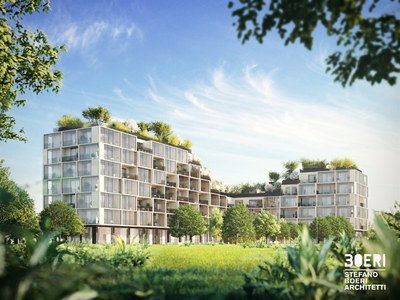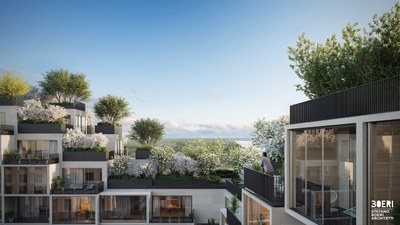Bosco Verticale goes to Belgium: Palazzo Verde will be the first Belgian project signed by Stefano Boeri Architetti and it is going to be the new landmark of Antwerp Nieuw Zuid district whose masterplan establishes that half of its surface – 12 hectares – is destined to be green.
The L-shaped building is located in a central plot of the masterplan designed by Bernardo Secchi and Paola Viganò, where it closes the side of the block that faces river Scheldt and embraces a semi-private green courtyard in its central part designed by belgian landscape architect Bas Smets.
In addition, from the courtyard, through a series of wide steps that also work as an amphitheater, you can access the Circularity Center where tenants and citizens can fix their bicycles and some other domestic objects.
The cascading structure of the building gives the possibility to host a small forest that is going to unfold itself on three terraces at the fourth, sixth and seventh floors: botanist Laura Gatti has selected specifically native species and has worked with the concept of forest and its undergrowth to give every terrace, the tenants can access to through staircases, a protected and inclusive space that it is obtained by placing trees and shrubs on the edges of the terraces.
Consequently, thanks to 86 trees, 2200 shrubs and perennials for a 428,88 square meters of green surface, this new project will immediately become the greenest building in Belgium: in fact, with the semi-public garden at the ground floor and the three huge terraces designed to host three roof gardens, Palazzo Verde is going to give its own contribution to fight air pollution absorbing 5.5 tons of CO2 per year.
Finally, the whole building has 67 apartments and it is designed according a grid of 5 x 5 meters, with the possibility of having 6 apartments at the building’s heads with a double or triple exposition and private terraces: in particular, balconies are mantained as exterior spaces, treated with white plaster and a wooden pavement, while loggias are finished with a wooden cladding so that it s possible for the tenants to annexe this space to their unity extending its living surface.
In conclusion, public and private space perfectly blend into one another in this new project that integrates architecture with urban and environmental context also incorporating huge portions of nature.






